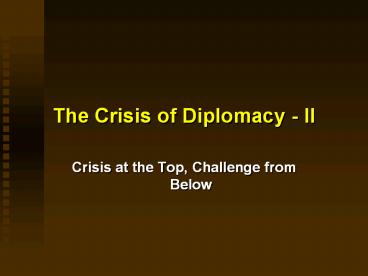The Crisis of Diplomacy - II - PowerPoint PPT Presentation
Title:
The Crisis of Diplomacy - II
Description:
The Crisis of Diplomacy - II Crisis at the Top, Challenge from Below – PowerPoint PPT presentation
Number of Views:123
Avg rating:3.0/5.0
Title: The Crisis of Diplomacy - II
1
The Crisis of Diplomacy - II
- Crisis at the Top, Challenge from Below
2
Split from Without
- The Indochina consensus was broken by outside
pressures, i.e., peasant resistance student
protest - Which led to different re-evaluations of costs
benefits - More more members of the establishment decided
policy must be changed - But those closest to power resisted persisted
3
Split from Within
- Kissinger et al refused to listen to the voices
of change from within the establishment - Those cut off from the White House any
influence sought other ways
4
New Institutions for Renewal
- So, the establishment went its own way
- went to the press (unheard of)
- created new forums for rebuilding consensus,
e.g., (Foreign Policy magazine) - created new organizations for maintaining
cohesiveness of Western Alliance, e.g.,
Trilateral Commission - created by David Rockefeller Zbigniew
Brzezinski in 1973 - member Jimmy Carter to relegitimate Presidency
(new concern with human rights, etc.)
5
Return of the Right Wing
- Banned from the corridors of power after the
McCarthy, China Lobby attacks on liberal
internationalism - The crisis in Keynesian Era, including that in
the establishment created an opening for a
rebirth - Right Old conservatives New
neo-conservatives - Right wing set about building counter elite
institutions and new coalitions around old themes - e.g., free markets, monetarism, neoliberalism
- e.g., nationalism, anti-communism vs detente
(Committee on the Present Danger) (Carters New
Cold War gave official cachet)
6
Waiting in the Wings
- Right Wing Institutions for Policy
- Neoconservative journals Public Interest,
Commentary - American Enterprise Institute Neoliberal policy
interventions - Hoover Institute Cold War renewal
- Heritage Foundation Mandate for Leadership for
Reagan - National Association of Scholars attacks
liberals in education - Georgetown Center for Strategic International
Studies - Conservative studies conferences
7
Ronald Reagan the Counter-Establishment
- First Reagan Administration staffed with a few of
old establishment, e.g., George Bush - But, mainly with as many new, Right wing
counter-establishment people as possible. - In economics supply-side economics, tax cuts,
deregulation, attack on social programs - In politics Evil Empire, anti-big-govt rhetoric
8
Hughes Reversals
- Hughes of establishment Carnegie Endowment
- Four reversals in foreign policy with new Right
- from respect for international law to whatever
it takes - from using insternational institutions (UN,IMF)
to nationalist antipathy towards them - from detente (economic ties as means to avoid
war) to roll-back - from multi- to uni-lateralism distain for
international cooperation
9
Liberal Establishments Revenge
- Excluded at last, the old liberal establishment
turned its guns on the new administration - for incompetence (e.g., arms control talks,
Irangate) - for putting ideology before pragmatism (rabid
anti-Communism, Contras, etc.) - Arthur Schlesingers critique of the substitution
of dogmatic ideology for empirical/pragmatic
approaches to foreign policy theory practice - Public criticism in journals, Congress, talks
- Iran-Contra exposure attack (like Watergate)
10
From Establishment to Professional Elites?
- Destler, Gelb Lake interpret all this as a
replacement of old establishment by a new,
professional elite - But they extend this new elite backward to
include people like Kissinger Brzezinski who
worked within the old establishment - As well as themselves -who participated in the
takeover of the executive wing with Carter - So, for them the Right-wing counter-establishment
right side of the new professional elite
11
Continuing Conflicts - I
- Conflicts within First Reagan Adminstration led
to - Quite different Second Reagan Administration
- less ideologically extreme
- more coherent in dealing with Soviet bloc
- but continued basic policy directions
- Contras, Grenada, Panama
- Bush Administration
- Continued 2nd Reagan directions including
willingness to intervene militarily (Gulf War)
12
Continuing Conflicts - II
- Bushs Gulf War led to coalescence of grassroots
opposition that had developed in 80s around - opposition to draft
- opposition to military intervention in Central
America - opposition to Grenada Panama invasions
- opposition to immigration policies
- Clinton Adminstration
- changed little from Bush policy directions
- continues NAFTA, support for foreign dictators,
etc.
13
--END--































